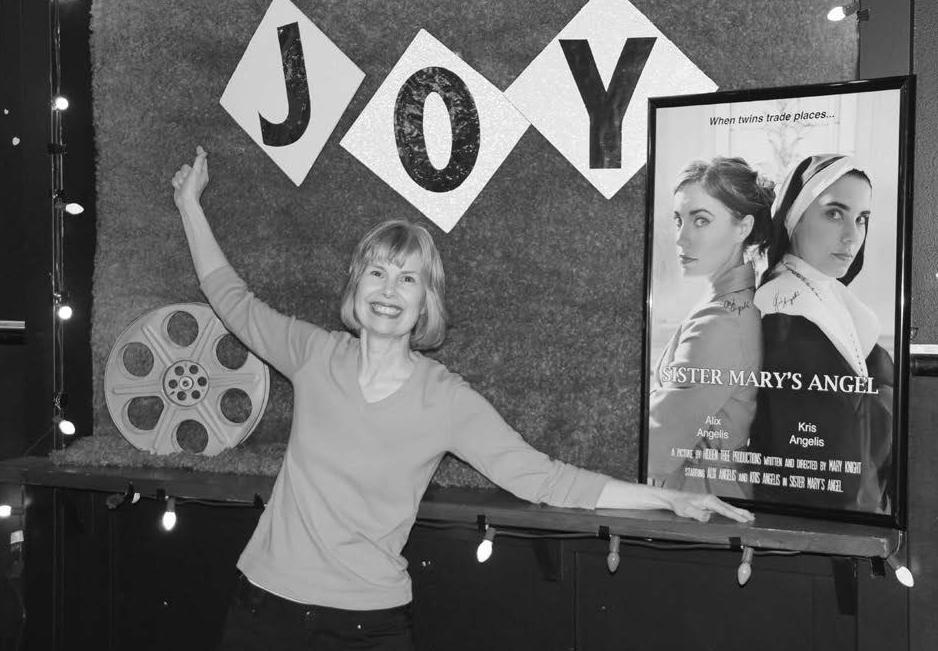
15 minute read
THE MAGIC OF CREATIVITY
By Mary Knight
The Beginning Of My Creative Journey
I used to think of myself as boring. My closet contained only muted colors. I hid my figure in baggy, shapeless clothes.
I was studious, ultrareliable, and extremely helpful but, by my own assessment, not particularly interesting. How did I evolve into an independent filmmaker whose personal documentaries have been viewed by several hundred thousand people?
It all started when I took a creativity class. The class was offered at a community college and cost just $99. It did not seem like a big deal at the time. But it changed my life!
The class was my attempt to do something just for fun. It would be just for me, some “mom time.”
My older son was headed to middle school in a year. This would be my last year as his homeroom mom. I had been homeroom mom every year that my sons were in elementary school, which can be considered a status symbol for an elementary school student but not so for a mature middle schooler.
One day, instead of going to my sons’ elementary school as usual, I drove to the local community college. Creativity was an “adult education” class. There were twentyone students, all women. We sat in wooden desks designed for college students. I had forgotten how uncomfortable they were, especially for my forty-year-old body! None of us could be mistaken for college coeds. I was not the only one shifting in my chair.
We introduced ourselves by telling our reason for taking the class. The answers given included to become a professional chef, to direct films, to make use of the art degree received when much younger, to design clothes, to paint a mural, and, from at least five people, to write a novel. My answer: “I’m taking this class for my own enjoyment. That’s the only reason.”
Our “textbook” was The Artist’s Way: A Spiritual Path to Higher Creativity by Julia Cameron. The premise of the book is that to create, you need to feel treasured, like an extremely well-cared for child.
The book and the teacher exhorted each of us to provide this level of nurturing to ourselves. As an adult, the only person from whom I can receive complete comfort is me.
Cameron spent her early adult life as a successful screenplay writer and as an alcoholic. When she quit drinking, she quit writing. She found her way back to creativity through self-care. She preaches the importance of daily journaling. This journaling needs to be done first thing in the morning, before your feet hit the floor. I found that by religiously doing “morning pages,” I often could remember my dreams.
Another essential part of Cameron’s creativity campaign is to take yourself on something that she calls an “artist date.” It is taking yourself on an outing that your younger self would have enjoyed. Examples include visiting an art museum, taking a fingerpainting class, browsing at a bookstore, window shopping at an exclusive boutique, and going on a carnival ride. It should be just for fun and just you, a solo outing (although I do cheat sometimes and bring another art lover along).
The class took place every Wednesday evening for thirteen weeks. By week eight, the original twenty-one students had dwindled down to five. By week ten, there were only three of us. The three of us kept in touch for a while after the class ended. To my knowledge, I alone remain involved in creative endeavors. Why do so many people quit before finishing their artistic projects?
Creativity is hard work! It can be exhausting to care for a newborn, and the same is true of nurturing your fledgling artist self. But, if you provide the right conditions, creativity can expand until it feeds your soul.
By the end of the creativity class, I wanted to write a short story. However, I was told that the novel-writing class at this community college was better than the one focusing on short stories, so I took it. I loved the teacher. The next semester, I took her advanced class. It was for screenplay writers as well as for aspiring novelists. I met a student in that class who liked an idea that I had for a novel and offered to co-write if we could use the idea for a screenplay before writing the novel. He quit as my co-writer before we finished the script, but I was already hooked. Screenplay writing, with its strict page count expectations, is like poetry. It depends heavily on symbolic images. The focus is “show, don’t tell.” I began to visualize what I wanted my viewers to see on screen. I learned to delete all unnecessary dialogue.
SISTER MARY’S ANGEL
Sister Mary’s Angel, PG-13, is a romantic comedy with depth. It is my fun film.
Runtime is eighty-seven minutes. It stars identical twins Kris and Alix Angelis. It is available to view free of charge on my website and on my YouTube channel.
The screenplay that I wrote was Sister Mary’s Angel, a fictional story about identical twin sisters. Angel, a lingerie model, has an urgent need for medical care. She has no savings, no health insurance, and no options in her pre-Obamacare world. She trades places with her identical sister, a nun, so that the Catholic Church will pay for her surgery. It is a dramatic comedy with child abuse in the backstory.
The idea for Sister Mary’s Angel came to me when I was at Starbucks with an elderly, vivacious ex-nun from my book club. She said, “When I became a nun, there were two paths for a Catholic girl who had been molested: become a nun or become a prostitute.” In my original draft, the lingerie model was a prostitute. (Back then, I used the term “prostitute” rather than “sex trafficking victim” which is the term that I always use now.) I changed the character based on advice from Jean Smart. I saw her when we both were in the audience at a film conference. I recognized her from her iconic role in the sitcom Designing Woman from the 1980s and 1990s. I rushed up to her, not knowing what to say except for the elevator pitch for my script. Smart told me that my script would be more appealing to someone like her if its’ characters were more subtle.
I was passionate about the script because it contains a sermon. The convent priest knows that the sisters switched places, but he does not report them. Having been told about the switch in confession, he is bound to confidentiality.
The lingerie model, although not Catholic, comes to trust him during her time in the convent. She asks him, “Where was God when my dad used to mess with me? ” The kind priest answers, “Angel, I can’t know the answer to that for you, but for me, when my dad used to beat me, God was there. He was holding my hand, and He was crying.” The words of the priest came from my own personal experience, and I cherish the opportunity to share them with fellow survivors through film.
I made many attempts to sell this script. I got good at pitching it, but then again, I had lots of practice! I went to the Austin (Texas) Film Festival and to the Willamette Writers’ Conference (Portland, Oregon) multiple times.
There I met agents and producers. My script went to Hollywood by invitation, but my eventual reply was always a “No” (often the Hollywood “No,” which means that I never heard back).
After a decade of fruitless effort, I decided that if I shot a couple of scenes of the movie, I would have an easier time selling the script. In 2006, I took my first filmmaking class. I thought that was all that I would need to do. I later found that far more effort and resources were needed.
In my film-making class, my teacher asked us to make a short, relatively simple film. It had to be less complicated than any of the scenes in my script for Sister Mary’s Angel. The film that I produced was titled One Man’s Anger, One Woman’s Love. It is described in the next section of this essay.
After I had successfully made a short film, I naively thought I was sufficiently knowledgeable to make a long one. If I had known enough to correctly estimate the time and money that making a narrative fictional film requires, I never would have made one.
My first attempt to make Sister Mary’s Angel was during the summer of 2009. As I look back, I wonder how I had the gumption to spend my time and money on film-making when I was living in a shared house and could barely pay rent. I badly underestimated the cost. On the other hand, I experienced success as I made cold calls to find free filming locations. I not only got permission to film in the Portland Rose Festival carnival area, but I also was granted media passes so that we could enter without paying the admission fee.
Experienced local actors volunteered to play the supporting roles, but I needed identical twins to be the stars. I found a set of twins on Craigslist who lived 100 miles away. They had hardly any acting experience and yet turned out to be prima-donnas. I offered them no financial reimbursement, but, since I was filming on a weekend when the other people in my shared house would be out of town, I agreed to let them sleep in our living room. Instead, they insisted on sleeping in a bedroom that I had no right to use. I allowed them to use the bedroom and, as a result, was kicked out of the house. This experience showed me that I probably never would be able to produce my film. However, soon after, there was a major change in my personal life.
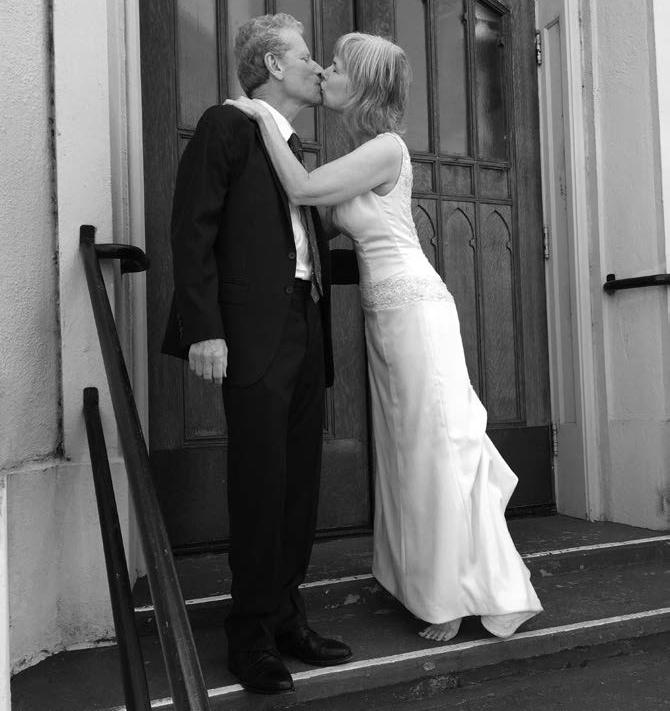
I met my husband, Jerry, while I was in the midst of working on the film. Four months after we started dating, Jerry’s ninety-five- year-old mother died, and he received an inheritance. Jerry wanted to contribute a large portion to charity, but I convinced him that my film would be a great way to help people. Before we were even engaged, Jerry agreed to cover my new $15,000 budget, which ultimately turned into an expenditure of well over $50,000. When people turn to me for advice on how to fund a film, I tell them that I have none.
The twins who appeared in the film were not the ones whom I originally had selected. I found out that I qualified for the SAG (Screen Actors Guild) Ultra Low Budget category, which enabled me to pay union actors a flat fee of $100 a day. I found actors on the SAG website who listed “twins” under special abilities. However, I found that some had a twin sibling, but the sibling was not an actor, or they both acted but were not identical. Finally, I found identical twins, Kris and Alix Angelis.
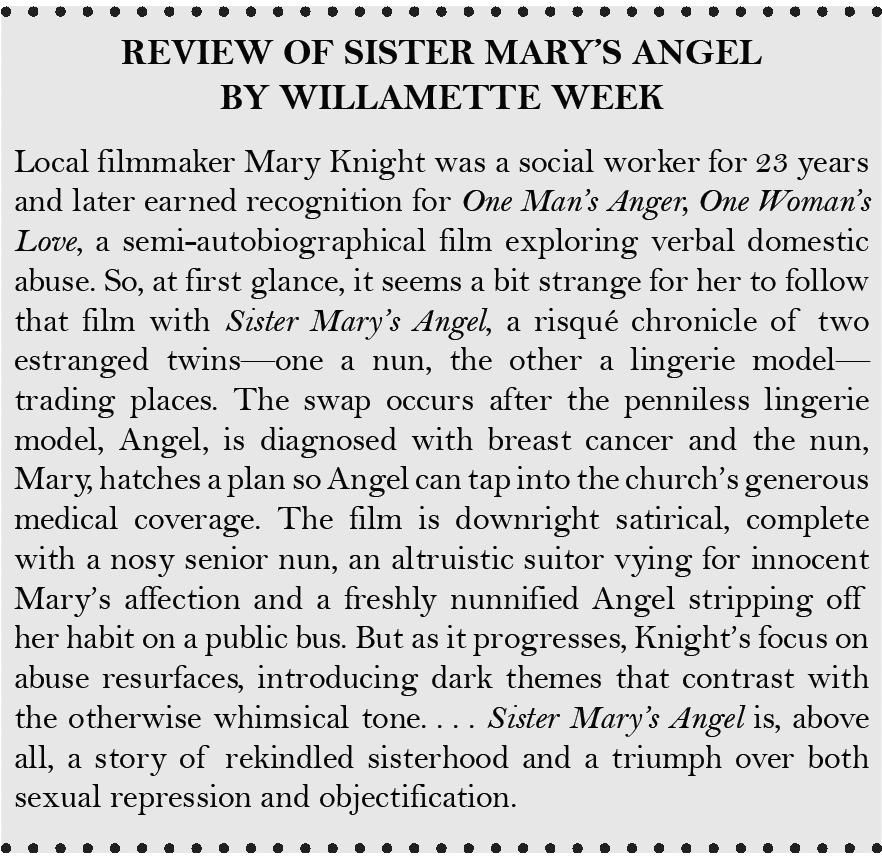
Kris lived in Seattle and offered to drive to Portland for an audition. Rather than purchase an airline ticket for Alix, I asked Kris to audition for both of them. She was great! Kris told me that her sister Alix is a better actor than her, which is something Alix would never say. Almost all the people who view the film think the twins are equally talented, but every now and then, someone will express a preference. What is interesting is that when they do, half say Alix, and the other half say Kris.
The 2012 Willamette Writers Conference was an easy drive from my Portland, Oregon, suburb. I knew that Hollywood agents, managers, and producers arrive at the hotel the day before the conference. I saw film executive Luke Ryan, who had a first-look deal with Tri-Star at the time. He was waiting in line to check in. He remembered me from previous conferences. (Most people do after hearing about my extreme childhood abuse.) I told him that I had finished editing a couple of scenes for my film and asked him to watch for three minutes. His look said to me that he wished he could get out of it but he did not know how to do so. Ryan sat beside me, watching the clip on my laptop. When he got back to Los Angeles, he watched the full eighty-seven- minute film and showed it to his business partner. Sadly, they ultimately rejected it.
I never was able to sell Sister Mary’s Angel. I still am glad that I made it. I joke with Jerry that, someday, when we are in an old folk’s home, we will have fun watching it. We will brag about it to the other elderly residents.
You do not have to wait for the nursing home showing! You can view it on my website and my YouTube channel
I think of this film as though it were my daughter. Parental pride compels me to include the Willamette Week review. This local paper announced Sister Mary’s Angel’s 2014 Portland, Oregon, premiere. Its reviewer gave the film four stars out of five, more stars than it did the Meryl Streep movie that came out the same week!
If you are not a filmmaker, you may be wondering how I managed to spend more than $50,000. That is a lot of money! If you are a filmmaker, you are wondering how I made any kind of film on so little money.
I underpaid every single person who worked for me. Each time I see the film, I appreciate the efforts of all the volunteers and underpaid individuals who made Sister Mary’s Angel possible! It was a labor of love for everyone who worked on it.
We shot Sister Mary’s Angel in twenty-two days. The timing worked for us to again use the carnival area of the annual Portland Rose Festival. I needed additional locations. My first indoor location was secured when I gathered the courage to walk up to the register at Portland’s iconic Movie Madness video store, and the owner just happened to be present. Three Doors Down, an upscale restaurant, donated space, charging only the cost of one employee’s hourly wage.
A medical doctor let us use his office early in the morning before he opened for business, and his receptionist was so excited about being on a film set that she volunteered to be there. I appreciated what they did so much that I transferred to them for ongoing medical care. The wedding scene took place at the church I attended, and for the funeral, we used a wedding chapel that was originally a church building. We needed to build a set for the lingerie model’s apartment, where much of the film was shot. I persuaded Jerry to let me use his office. I thought his office would be completely functional while being used as a set, but I was wrong. With a king-size bed donated from a local mattress store and walls painted by a highly creative, budgetoriented volunteer art director, it looked so much like a lingerie model’s apartment that the longtime UPS delivery person came in the door one day and then left thinking he had come to the wrong place.
My husband Jerry and almost everyone else who had any part in making the film is an extra in it. If you look closely, you can see Jerry’s brief appearance in the first scene. I am in the first bus scene, clad in wacky Mickey Mouse overalls. You might not recognize me, as my hair was dyed reddish brown back then. I am in the bus seat behind Alix Angelis, who plays the lingerie model character named Angel. Since her character is posing as a nun and is dressed in a full-length nun habit, a Catholic woman approaches her to ask for marital advice. Angel/Alix tries to help the woman and, in a not so nun-like manner, inquires about her sex life. On camera, you can see my shocked expression peek through as Alix asks the alarmed, modestly dressed, ultrapious Catholic character, “Is he good in bed? ”
Most makers of independent low-budget films do not request a rating from the Motion Picture Association because of the cost. I consider the $3,000 that I paid to get Sister Mary’s Angel rated well worth the cost. The fee charged is on a sliding scale based on the film budget. I paid the minimum. Steven Spielberg invests over $20,000 per film for the exact same service that I received. Sister Mary’s Angel was given a PG-13 rating, which is what I wanted. I was surprised to receive a phone call from a member of the rating committee. My smile wide, I cradled the phone as I was told that they were impressed with the film’s message.
This story is an excerpt from Mary’s book My
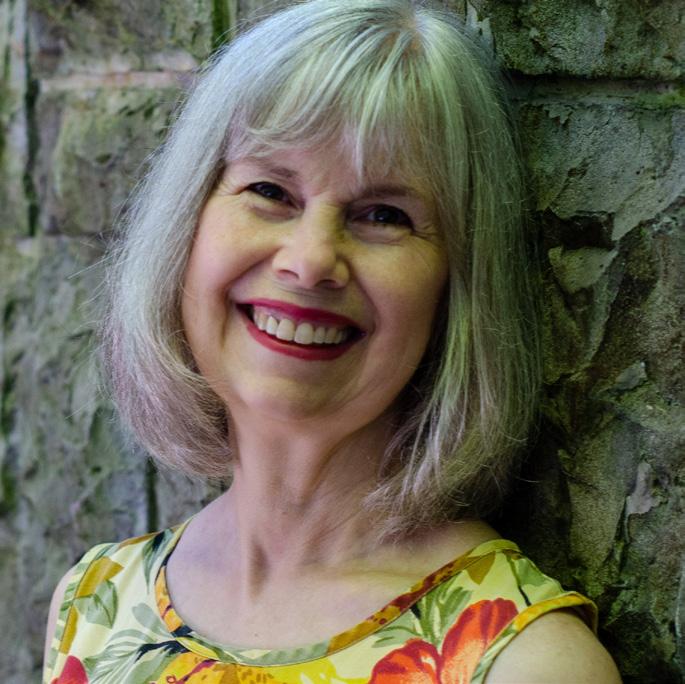
About The Author
Mary Knight, MSW, experienced various forms of child sex trafficking, sometimes in her own home. Her parents were her pimps. Knight’s current life is filled with safety, love, joy, and children. Happily married, she is a child advocate, a foster parent, and a grandmother. Knight lives in Bellingham, Washington. She can be contacted by email or through Facebook. Her memoir My Life Now: Essays by a Child Sex Trafficking Survivor is available through Amazon, and can be ordered from any independent book store. Her films are all free on Mary’s YouTube channel.
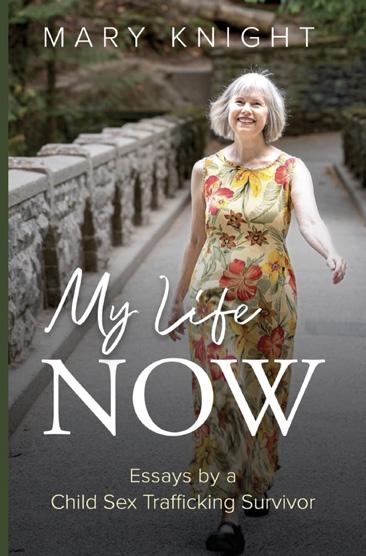
41










